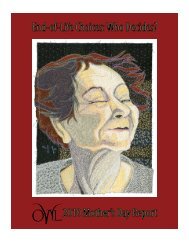elder abuse: a women's issue - OWL-National Older Women's League
elder abuse: a women's issue - OWL-National Older Women's League
elder abuse: a women's issue - OWL-National Older Women's League
You also want an ePaper? Increase the reach of your titles
YUMPU automatically turns print PDFs into web optimized ePapers that Google loves.
Dementia and Elder Abuse: Research indicates thatpeople with dementia are at greater risk of <strong>elder</strong> <strong>abuse</strong>than those without. 16 17 A recent study revealed thatclose to 50% of people with dementia experience somekind of <strong>abuse</strong>. 18 Approximately 5.1 million Americansover 65 have some kind of dementia. Close to half ofall people over 85, the fastest growing segment of ourpopulation, have Alzheimer’s disease or another kind ofdementia. By 2025, most states are expected to see anincrease in Alzheimer's prevalence. 19 Women over 90 aresignificantly more likely to have dementia than men ofthe same age. 20Chronic Illness and Abuse: In 2005, 44% of thoseage 75 years and over living in the community reportedhaving a limitation in their usual activity due to a chroniccondition. 21 Gender disparities in functional status arenotable, with more women over 65 than men havingproblems performing activities that are important forindependent functioning. 22Mistreatment in Nursing Homes and Other Long-Term Care Facilities: Over 2.8 million older Americanslive in the nation’s 64,000 licensed care facilities. 23 Justover 5% of the <strong>elder</strong>ly were in nursing homes in 1985,down to 4.6% in 1995, for an annual decline of 0.7%. 7The Long Term Care Ombudsmen reported receivingalmost 14,000 allegations of <strong>abuse</strong>, gross neglect orexploitation in 2007. 24 A 2008 study conducted by theU.S. General Accountability Office revealed that statesurveys understate problems in licensed facilities: 70%of state surveys miss at least one deficiency, and 15% ofsurveys miss actual harm and immediate jeopardy of anursing home resident. 25Impact of Elder Mistreatment: Elders whoexperienced mistreatment, even modest mistreatment,had a 300% higher risk of death when compared tothose who had not been mistreated. 26 Women whoexperienced psychological or emotional <strong>abuse</strong> (alone orwith other kinds of <strong>abuse</strong>) had significantly increasedodds of reporting joint, heart and digestive problems;depression or anxiety; and chronic pain. 27 Elder financial<strong>abuse</strong> costs older Americans more than $2.6 billion peryear. 28America’s Response to Elder Abuse - Silence Isn’tReally Golden: Current federal resources devoted tothe problem of <strong>elder</strong> <strong>abuse</strong> are minimal. The SenateSpecial Committee on Aging estimates that less than2% of federal “<strong>abuse</strong> prevention” dollars go to <strong>elder</strong>mistreatment efforts (though <strong>elder</strong>s comprise 12% ofAmerica’s population).At the U.S. Department of Health and HumanServices (HHS):• Adult Protective Services, the front line responderto <strong>elder</strong> <strong>abuse</strong>, does not even have a federal officeor federal standards, oversight, training, datacollection or reliable funding.• The <strong>National</strong> Institute on Aging, which leads thefederal effort on aging research, last year spentonly about $1 million (or 1/1000 th of its annual$1 billion budget) on <strong>elder</strong> <strong>abuse</strong> research, a smallfraction of what it spends on other <strong>issue</strong>s.• The Centers for Disease Control and Preventionlast year spent just $55,000 of its $8.8 billionannual budget (0.00062%) on <strong>elder</strong> <strong>abuse</strong> <strong>issue</strong>s.• Recent Government Accountability Officereports cite serious care and oversight deficienciesin facilities funded and regulated by the Centersfor Medicare and Medicaid Services, oftenresulting in <strong>abuse</strong>, neglect or even death of frail<strong>elder</strong>s. A study by Rep. Henry Waxman’s officefound <strong>abuse</strong>-related deficiencies in one third ofnursing facilities.• The Administration on Aging spends about $6million (0.5% of a $1.4 billion budget) on <strong>elder</strong><strong>abuse</strong> efforts, plus $16 million on the Long TermCare Ombudsman program.• Elder <strong>abuse</strong> is not just a health <strong>issue</strong>. It also oftenis a federal, state or local crime or a civil offense,albeit one that is rarely recognized or prosecuted.At the Department of Justice (DOJ):• The Office on Violence Against Women (OVW)spends only 1% of its funds on <strong>elder</strong>s, whocomprise 20% of the adult population but arerarely served by domestic violence programs.• The Office of Justice Programs (OJP), DOJ’sgrant-making arm, in FY 2008 spent less than $2million (less than 0.5% of its $2.3 billion 2008budget) on <strong>elder</strong> justice efforts.• Current federal <strong>elder</strong> justice efforts are sporadic4



